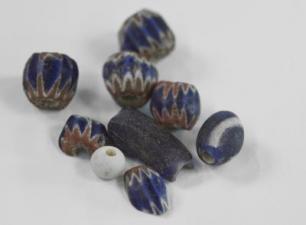
Section Branding
Header Content
The Conquistador Stopped at a Georgia Swamp
Primary Content

In the spring of 1540, the Spanish explorer Hernando de Soto and about 600 men began traveling north fromTallahassee in hopes of finding a city of gold. The conquistador would die two years later, broke, in bad health and in poor spirits, on the banks of the Mississippi River somewhere around present day Arkansas.
Much of what happened in those two years remains a topic of controversy for historians and archeologists. And there is great disagreement over the exact route de Soto took as he traveled through Georgia in the spring of 1540.
Now, a Georgia archeologist says he has pinpointed parts of de Soto’s route through the state. Dennis Blanton is the curator of Native American Archeology at the Fernbank Museum of Natural History. Blanton’s team found beads, metals and a silver necklace in Telfair County, on the edge of a swamp near the Ocmulgee River.
“Outside of Florida, nothing like this has ever been found. And finding the silver piece was almost startling," Blanton says. "These are the kinds of things, that we know, by comparison with other de Soto sites, especially in Florida, that fit the bill of an area de Soto traveled through.”
Many scholars have speculated that de Soto crossed the Ocmulgee near Macon. Blanton’s findings suggest de Soto’s expedition came through some 80 miles to the Southeast of Macon. That's contrary to many scholarly reports, as well as the designated route taught in schools.
Blanton found the artifacts almost by accident. His team was looking for remnants of a Spanish Mission established almost 100 years after de Soto’s expedition.
Now, his team’s excavations and discovery have put him at the center of one of the most contentious scholarly issues in the Southeast.
“The archaeology speaks for itself, and we have to take this as where he came through at face value,” Blanton says.
Beads were used as a type of currency the Spanish gave to curry favors with the natives. The silver artifact is believed to be a necklace fashioned out of a coin from the period. Blanton believes the discovery could help pinpoint other stops the expedition took as they headed towards the Carolinas. There are only two other sites where most scholars believe de Soto stopped. One is Tallahassee area where the group departed.
One of the few details in de Soto’s journals about the trip through present day Georgia is that he baptized natives in the Ocmulgee. His expedition would travel northward through the state, heading into the Carolinas, where de Soto had heard a woman chief led a rich, prosperous city. The Spaniard did find the city, but instead of gold, found copper and pearls. He would spend the rest of his life searching for a passage to the Orient, a quest that eventually took him to the Mississippi River.
Fights with natives, illness, and disaster would thin the ranks of his expedition. After de Soto died, the remaining members traveled back towards Mexico, with some of them eventually reaching Mexico City. For many years, the de Soto expedition would be looked at as a complete and utter failure, as it achieved none of its objectives. Meanwhile, de Soto himself would be compared to Cervantes' fictional Don Quixote, although, it should be noted, de Soto was more of a brute and less of a bumbling idiot.
Still, the expedition had lasting effects. Scholars say accounts of the native civilizations he encountered were the first, and in some cases, last, records documenting the great, socially complex Mississippian Indian cultures. There is a question of just how much de Soto’s expedition changed those cultures, which had largely disappeared or changed when other European explorers started coming back through the area a century later.
The trip also had an effect on the environment. The de Soto expedition brought horses, dogs, and pigs, many of which got loose or lost during the journey. Razorbacks, the wild porkers that also serve as the mascot for the University of Arkansas, first appeared in the Southeast most likely as part of the de Soto posse.
“When de Soto showed up, that was the moment when two worlds began sharing the same story,” Blanton says. “When de Soto arrived, the world changed forever. It undid the ancient culture that had been in the Southeast for so long, and it gave the Europeans information that would later be put to use as they began to expand their realms into this part of the world.”
Blanton’s findings suggest part of that seismic change happened on the edge of a swamp in Georgia’s Telfair County.
Learn more about the de Soto expedition here: http://www.learnnc.org/lp/editions/nchist-twoworlds/1694
Tags: Hernando de Soto, Fernbank Museum, Telfair County
